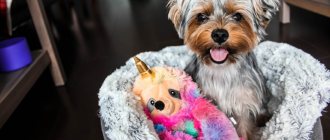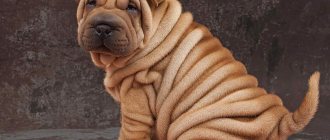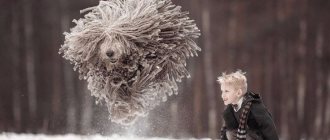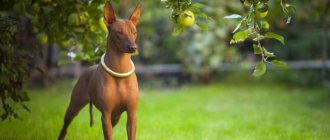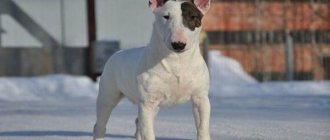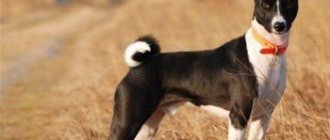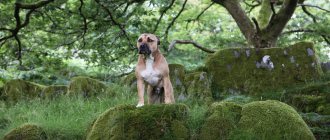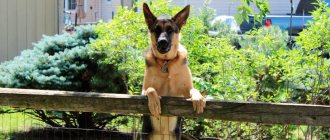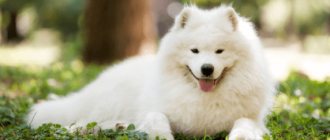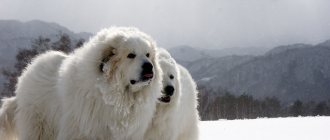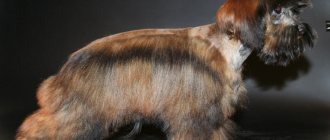The Chow Chow breed is one of the most ancient. In the 200s BC. it already existed. Don't believe me? In clay figurines belonging to the Chinese Han dynasty, one can easily recognize quadrupeds of this species. Unfortunately, detailed information about the history of the breed has not been preserved, because at one time they were destroyed by order of Emperor Qin Shi Huang. But it is a fact that fluffy dogs were popular not only in China, but also in Ancient Egypt, Tibet, and Mongolia. It is believed that Spitz and Tibetan mastiffs are directly related to the origin of the Chow Chow.
Today, miniature “shaggy lions” are no less popular. The breed is even included in the FCI list, where it occupies an honorable place in the 5th group (Spitz and primitive breeds), 5th section (Asian Spitz and related breeds). Thanks to established breed standards, you can find out what a Chow Chow looks like:
- This is a strong and well-built medium-sized dog (height at the withers: 46-56 cm, weight: 20-32 kg), which is noticeable in the photo. This breed has an unusual gait called stilted;
- a flat and wide skull, an elongated muzzle, a light nose, rounded hanging ears and dark oval eyes are the features by which you recognize a dog. But the hallmark of the variety is the language. Why does the Chow Chow have a blue tongue? If you believe a funny and beautiful Chinese legend: once upon a time a chow chow managed to lick a piece of the sky;
- the body is straight and powerful, with a broad chest and high-set tail;
- the limbs are straight, the bones are strong, the hind legs are more muscular than the front legs.
All four-legged animals are divided into long-haired and short-haired. The former can boast of luxurious “hair”: their coat is straight, thick and coarse. The covering is especially abundant around the neck and on the back of the thighs. Short-haired dogs (smooths) have loose, dense fur with a plush-like structure. The breed pleases with a variety of colors:
- black chow chows;
- red dogs;
- blue chow chow;
- red dogs;
- dogs with cinnamon color;
- cream quadrupeds;
- Chow Chow with white coat.
According to the characteristics, different shades of the same color are acceptable, but spots indicate that the dog is not purebred.
How long do “shaggy lions” live? Representatives of this species have the greatest variation in life expectancy figures. Four-legged animals can delight their owners with their presence from 9 to 15 years.
Calm character of the Chow Chow
Chow-chows are bright individualists who are owner-oriented. A dog is a “litmus test” of the owner’s mood. Are you sad? The dog will support you by placing his head on his knees. Are you feeling a surge of joy? Your four-legged friend will also show positive emotions, backing them up with a contented grumble. Pets are sensitive, but the nature of the Chow Chow is such that they never express their emotions too violently.
These dogs can be offended if their opinion is not taken into account! In this case, the animal’s behavior becomes distant - from the outside it may seem as if the pet does not hear or see you. Chow chows and children get along well if the dog is raised properly. But often animals simply tolerate excessive attention from children. Based on the description of the breed, the dogs are loyal and love affection, but in moderation.
Why "chow-chow"?
As well as versions of origin, there are several interpretations of the name of the breed.
- Thus, the word “chow” in Chinese means “an animal that can be eaten.” And although gastronomic preferences for dog meat are more likely to be typical of Koreans, China has also never disdained this dish.
- However, the same Chinese have the word “kau” - “dog”, which is very close in sound to “chow”. The version is less bloodthirsty, therefore more popular.
- The rich Chinese language gives us another explanation. The word "Chow" denotes a dog distinguished by great strength and courage - these are the traits that are characteristic of real Chow Chows.
- The European version refers us to the English “chow-chow” - this was the name of special premises on merchant ships that transported dogs of this breed across the ocean.
Pet care: maintenance and feeding
The Chow Chow is a medium-sized dog breed, suitable primarily for living in an apartment. Although the pet has thick fur, it has no undercoat, so temperatures of -10C have a detrimental effect on the body of the four-legged creature. Should the animal be kept in an enclosure? The choice is yours. But remember that the dog should not freeze.
When choosing a place for your dog, rely on your four-legged friend - let the animal choose a secluded place for itself. But keep in mind that the dog should not sleep on the bed or sofa. When caring for a puppy, make sure that he does not climb under low furniture or jump from heights - this way you will protect the dog’s joints.
Chow Chow care includes occasional bathing (only when necessary) and regular brushing. You need to comb your dog every day, doing it against the growth of the coat. Accustom your pet to this procedure from an early age and an adult Chow Chow will show obedience during brushing. There are no special features when caring for eyes, ears, claws and fur. Eyes should be wiped with a damp cloth daily, ears cleaned once a week, and nails trimmed as needed.
Which food for chow chow to choose? First of all, nutrition should be balanced. And if you have free time, feed him natural food. Meals should consist of meat, fish, dairy products, cereals, fruits and vegetables. But these products should be excluded from the menu:
- bones, bone broth;
- pork, smoked meats;
- pasta;
- boiled potatoes;
- legumes;
- sweets and chocolate;
- raw carrots.
Feeding a Chow Chow puppy is carried out 3 to 5 times a day. An adult dog is fed 2 times a day, and dogs after 4 years of age are fed 1 time a day (in the evening).
Character
The breed is characterized by intelligence and pride. Self-esteem comes first. Independent, strong-willed dogs. The downside is stubbornness and domineering.
For the owner, the character of the Chow Chow is not a gift. Finding the right approach to a pet is more difficult than with other breeds. The dog really needs the attention of the human family, but at the same time, they can keep approval or disapproval to themselves.
The character of the Chow Chow is perfectly characterized by the phrase that has become popular among fans of the breed: “A dog is ready to die for its owner, but is not ready to obey him.”
Sudden changes in mood and lack of restraint in expressing emotions are characteristic of these dogs. They don't ask for respect, they demand it. The owner will need patience. While displaying mood swings, dogs nevertheless have very warm feelings towards both the owner and, to a lesser extent, all family members.
It is difficult to assess the behavior of this breed: they love the owner, but try to take a dominant position, are ready to give their lives for him, but do not strive to please.
The Chow Chow will not be embarrassed by any opponent if the owner is in danger. The dog will come to the defense without hesitation, using all the advantages: strong jaws, large dimensions, thick hair that protects from wounds.
Representatives of the breed are calm towards children, but if a child offends a pet, trust will be lost forever. They are distrustful of strangers - they will not show aggression without a reason, but they will not accept the attention of a stranger.
Sudden aggression can manifest itself towards other animals. He may be careful with the cat he grew up with, but this will not make it any easier for a street tabby: a chase is inevitable.
This problem can be solved by raising and socializing the puppy at an early age - to understand that aggression is not needed in most situations. It is worth remembering that centuries of work as guard dogs could not help but develop aggression as a natural reaction.
We advise you to read: Bolonka dog breed
Representatives of the breed form an opinion about people and animals at the first meeting, and in the future it remains unchanged: friend, enemy, acquaintance.
The chow chow chooses the “leader” in the house independently; the decision cannot be changed. She does not show off her tender feelings, but is always ready to help and protect. Restraint in everything: barely audible whining, poking with the nose, or a slight twitch of the tail can be used to show emotions. The dog expresses dissatisfaction by growling, the volume and intensity of which depends on the degree of anxiety.
The pet is sensitive to the mood and state of health of the owner, tries to help and comfort, but absolutely cannot stand excessive emotions and temper.
Neatness and cleanliness are inherent in the breed, probably from the time of upbringing in Chinese monasteries. Puppies quickly get used to the toilet, ask to go outside, and try not to get dirty. And high self-esteem does not allow one to stoop to such banalities as damaging household items.
Rarely gives voice. Silence is one of the qualities of the breed.
How to raise and train a Chow Chow?
Raising and training a Chow Chow is not the easiest process. But don’t rush to conclusions: the dog is not stupid, not lazy, and not even stubborn. The point is different: in order to understand how to raise and train a pet, it is important to realize that the dog has its own opinion. That is, she is not a blind performer, but a person who, if she obeys, does so with a sense of her own dignity. Do you think that an animal can be trained at home using the traditional “carrot and stick” method? Here you guessed wrong.
It is unlikely that when raising a chow chow you will induce him to follow a command by bribing him with a tasty cracker. The use of force will not help here either. As a result, the pet will withdraw into itself or show aggression, which in any case can be regarded as your fiasco. Only patience, understanding and kindness will allow you to tame this proud and smart animal. Therefore, first, establish contact with the dog. And the sooner you do this, the easier it will be to raise a friend. Dog breeders recommend training puppies from the first days you bring the animal into your home.
Can other breeds be blue?
What is considered a sign of purebred for a Chow Chow is called cyanosis in other dogs.
A change in the color of a dog’s tongue is an alarming sign for both the veterinarian and the animal’s owner. In the majority of cases, cyanosis indicates that the animal is sick .
Signs of cyanosis include purple or bluish colors, trouble breathing with pronounced shortness of breath, and bluish discoloration of the paw pads.
Blue tongue color is often found in animals living in the far north.
Cyanosis is not an autonomous disease, but a symptom. The condition of the mucous membranes directly depends on the oxygen entering the blood. If an animal’s body does not receive the amount of O₂ it needs, this can lead to tangible consequences, even death. In addition, genetic diseases, congenital heart defects, a variety of respiratory diseases and certain chemicals can cause blueness.
A fairy tale for children and adults. Why is my tongue this color? Some say that we ate too much blueberries, others say that we drank ink, confusing it with blueberry jam. But the history of our family is not comic, but heroic. Chao-Chao raised his head from his paws. The sun has already sunk into the sea. Only the reflections on the water reminded him of him. It was on such a night that this story happened. The dog began his story. The new moon has arrived. The cheeky moon hung in the sky. Everyone in the small village was already asleep. And in the mountains, high above the village, an old witch brewed a secret potion that could cure various ailments and heal any wounds. It should have been enough for a whole month, until the next arrival of the big moon. The recipe was known only to the old woman. It was passed down from mother to daughter on her deathbed. That night the witch was very worried. She felt that her strength was leaving her. In a month, my daughter will be cooking over a large cauldron. A witch cannot make mistakes. Each grass sank in its own time. Only when they were all immersed in the water could they begin to stir them with a long bamboo stick. The old witch took this stick in her hands and lowered it into the cauldron. She had difficulty completing the first lap of the water. And when she started the second, the stick pulled out of her hands and the old woman lost her balance. As she fell, she touched the cauldron with her hand. The witch didn't even get burned. Everything that belonged to the old woman could not harm her. The potion spilled from the cauldron into a mountain lake. The water darkened and began to boil. And after a few moments it began to rapidly arrive. The old woman woke up her daughter, and together they began to beat a huge frying pan hanging at the entrance to the cave. The small village below woke up, alarmed voices and barking dogs were heard. The old witch took the horn in her hands and shouted into it: “I spilled the medicine into the mountain lake!” It will boil until the morning, and the water will remain until the morning! We need to scoop it out, otherwise it will flood our village and wash away all life in the area! The women below began to shout. The children started roaring. The men began to gather for the mountains. - Wait! - a lonely old man told them. - There are too few of you. You won't have time to bail out the water from the lake. - What to do? — Take my dogs with you. You've never seen anything like this. This is a gift from my friend. They will help you. And he brought out twelve red puppies in a basket. — How can puppies help us? They are too weak to carry water. “They shouldn’t carry it,” the old man answered calmly. - They will lap it up. If your wives and children are dear to you, if you want to stay alive, take them with you. And the men took the old man’s basket with them. They didn't really believe him, but fear for their families made them obey. And the water kept rising. When the villagers reached the lake, it was already splashing at the very edge of the coastal mountains. There was no point in scooping it out with buckets anymore. Then they took the puppies out of the basket and laid them on the ledge of one of the rocks. Imagine the surprise of the men when the red lumps began to lap up the dark water like milk. It was still seething, but it began to subside. And the puppies kept lapping and lapping. The lower the water level became, the larger they became. By morning, twelve huge red dogs with blueberry tongues were sitting by a quiet mountain lake with clean drinking water. The villagers were saved. And the old man gave each house a dog. Many centuries have passed since then, but our family is revered in those places. “Aren’t you sled dogs?” — I asked in surprise. “Anything has happened,” the dog answered proudly. - We always come to the rescue. Chao-Chao stood up and walked along the seashore to his home. As always, without looking back.
To answer this question, you need to familiarize yourself with the shrouded in secret history of the origin of this breed, because in this case there is no talk of any artificial selection.
The Chow Chow is a very ancient breed, and DNA tests taken from dogs of this breed fully confirm this fact.
The most common version is the assertion that Chow Chows first appeared in China, as evidenced by clay figurines dating back two thousand years BC, which depict four-legged friends of a person of this breed. But recent excavations of Bronze Age settlements carried out in central Siberia indicate a different line of origin for this wonderful breed. Dogs were only partially domesticated by humans during the Bronze Age, and the characteristics of ancient animals found during excavations led researchers to believe that Bronze Age dogs were the likely ancestors of modern chow chows. The study of the remains made it possible to assume that the chow chow came from an animal that was an intermediate link between a small Asian bear and a dog, and bears, as is known, have a black tongue.
Some researchers have also hypothesized that the chow chow originated from extinct polar wolves, whose tongue pigmentation had a pronounced blue color. This hypothesis arose from the assumption that dogs appeared on Chinese soil when the Tatars constantly raided this land or arrived in China with their trading caravans. The bear dog came to Mongolia from Siberia, and before that it lived in the Arctic Circle. If the distant ancestors of the Chow Chow once lived in the Arctic Circle, where, as is known, the air is characterized by a low oxygen content, then perhaps the blue tongue of the Chow Chow is a mutational adaptation of animals to environmental conditions, for example, the tongue of polar bears also purple. People in their nature are also familiar with the acquisition of a blue color in the tongue, but when this happens, it indicates a lung disease when the body lacks oxygen.
However, despite a number of different hypotheses trying to explain why chow chows have a purple tongue, an exact answer has not yet been found. The Chinese have a charming legend that simply explains the appearance of such an unusual tongue color in this breed: once upon a time, a very long time ago , the chow chow licked the broken piece of the sky. In any case, the Chow Chow's blue tongue is an amazing feature and a sign of the purebred nature of this cute breed.
Health
Fluffy dogs have a strong immune system, but some diseases still threaten the health of dogs. The most common illnesses found in Chow Chows are:
- hip dysplasia. Unfortunately, the most common and most dangerous disease is also among other dog breeds (for example, shepherd dogs). The hip joint weakens, causing the top part to pop out of the bone. This leads to calcium arthritis, and the dog begins to experience pain when walking;
- eczema, allergies, dandruff. Diseases of the breed can be caused by both improper nutrition and improper care. After bathing, wipe the animal dry. If the wool does not dry out, the skin will lock, which will lead to the above problems;
- adrenal insufficiency. In this case, the dogs lose their appetite, their attraction to pets of the opposite sex, and the dogs quickly get tired. Acute illness in a Chow Chow may result in shock;
- eye diseases. Turning up of the eyelids and double eyelashes can cause your pet to develop keratitis or a corneal ulcer. In some cases, the health of the Chow Chow is threatened by retinal atrophy;
- heatstroke. The luxurious “fur coat” of the Chow Chow is not designed for the summer heat, so in hot weather it is better for dogs to stay in the shade, and ideally in a cool room.
If you take care of your pet, feed it healthy and tasty food, give preventive medications and get vaccinations on time, the animal will thank you with a wet nose and an energetically wagging tail.
Chow Chow Appearance
The fluffy, handsome
Chow Chow is one of the most recognizable dog breeds in the world. Amazing fur and dark tongue are the reasons for the animals' enduring popularity.
Height
The height at the withers of a male is from 48 to 56 cm, of a female - 46-51 cm.
Weight
An adult male weighs 25-32 kg, a female – 20-27 kg.
Head
The Chow Chow's skull is flat, wide, with good filling under the eyes. The stop is not pronounced.
Muzzle
Wide, medium length without a “foxy” point. The nose is wide and large, usually black. For fawn and almost white dogs, a light color is allowed, and for cinnamon (cinnamon color) and blue chow-chows, a natural shade of the lobe is allowed. The palate, lips (preferably, and gums) are black. The tongue is blue-black.
Eyes
Oval, medium size. The pupil is clearly visible. Chow-chows of blue or cinnamon color may have eyes that match the color of their coat.
Ears
Thick, small in size, rounded at the ends. Wide set, erect, but slightly inclined towards the eyes, which gives the muzzle a frowning expression.
Neck
Harmoniously curved and well set on the shoulders. Powerful, not short.
Chow chow muzzle
Back
Straight, short, strong with a powerful loin.
Breast
Deep, well developed with pronounced but not barrel-shaped ribs.
Tail
The Chow Chow's tail is set high and lies on the back.
Front legs
Absolutely straight, medium length. The backbone is strong.
hind legs
Black Chow Chow
Powerful, medium length. The angles of the hock joints are minimal, which gives rise to a “stilted” gait characteristic only of this breed.
Paws
The Chow Chow's paws are small, rounded, and raised at the toes.
Wool
Long – very thick, straight and erect with fairly coarse topcoat and soft undercoat. It forms a characteristic “lion’s” mane around the neck, and long “pants” on the back of the thighs are well defined. Intentional shortening of hair that changes the appearance of the dog is under no circumstances allowed.
Short (smooth) – very thick, has a plush structure. The hair is located perpendicular to the body.
Color
Be sure to have uniform pure colors - black, fawn, cinnamon, red, especially valuable - blue and white. Shades of the main color are allowed, but never spots.
Any deviation from the standard is a deficiency or a disqualifying feature, depending on the degree of its manifestation.
Care
- The Chow Chow's coat requires brushing. Once or twice a week. Dogs are sympathetic to the procedure, after which the hair does not become tangled and has an elegant appearance.
- You need to pay attention to ensure that all particles of dead fur are removed, otherwise this can lead to tangles and skin problems.
- The breed sheds twice a year. There is no need to cut your dog: wool is a natural protection for the skin and protection from sun rays. Its absence can lead to sunburn.
- Experts recommend bathing your dog no more than once a month.
It has been noted that males have longer and thicker hair. But it takes on the most elegant look from those dogs that spend a lot of time on the street or live in an enclosure. Puppies up to six months old have fluff instead of fur, which quickly gets wet and takes a long time to dry. It is not recommended to bathe babies before their first adult coat.
Representatives of the breed do not need serious exercise, but daily walks serve to maintain physical fitness. It is impossible to predict the dog’s reaction to events during a walk (those outbursts of aggression), so it is recommended to keep your pet on a leash; fortunately, the chow chows themselves have nothing against it.
A standard collar is not suitable for “plushies”: it spoils and wears out the fur. A narrow leather or fabric accessory would be a good replacement. A harness will also work.
An adult dog needs space. A large apartment may be suitable, but preferable is a private house, where the Chow Chow can fully demonstrate guard skills, protecting the property – its own and the owner’s.
Long exposure to the sun is contraindicated for “plush” dogs. They need shade and plenty of cold water.
A self-respecting dog will not eat something unknown. In addition, the increased tendency to allergies inherent in the breed requires special attention to food. Dry food is not suitable for everyone; it needs to have a reduced amount of protein and fat. Typically, breeders use specialized food for dogs prone to allergies or dietary food.
A high carbohydrate content provokes skin problems - the dog can scratch itself into open wounds and chew out its fur. Only a strict diet will help.
We advise you to read: Doberman Dog Breed

